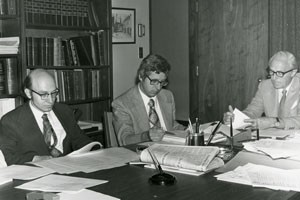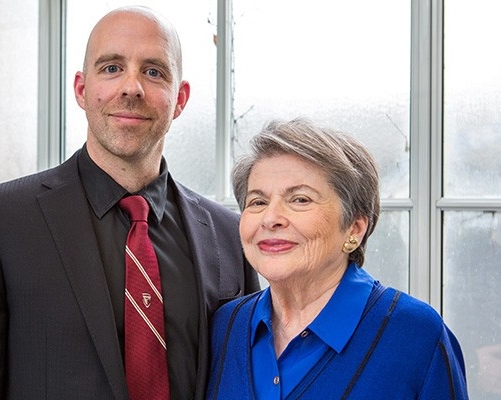Following the merger of Loyola College and Sir George Williams University, Concordia welcomes its first students in September.
Concordia comes from the City of Montreal motto — Concordia Salus — which means well-being through harmony.
Highlights of what we achieved in the 1970s

Following the merger of Loyola College and Sir George Williams University, Concordia welcomes its first students in September.
Concordia comes from the City of Montreal motto — Concordia Salus — which means well-being through harmony.

Concordia receives its first transmissions of CUTV.
TV Sir George, Canada’s oldest student-run television station — founded in 1968 — is consigned to history.

Henry J. Hemens becomes Concordia’s first chancellor.

Concordia is granted its first armorial bearings from Britain’s College of Arms. The coat of arms is designed by English professor David McKeen.

The Concordia Stingers athletic teams are established, along with bee mascot Buzz. The Stingers replace the Sir George Williams Georgians and the Loyola Warriors.
Concordia is one of the first 15 pilot centres to receive a Canadian Online Enquiry data retrieval computer in the Hall Building.

John W. O’Brien becomes Concordia’s first rector.

Fine Arts professors Donald Andrus and Sandra Paikowsky launch the Journal of Canadian Art History, Canada’s first journal devoted to the subject.

The Concordia Film Festival — North America's largest and oldest student-run film festival is first organized by the non-profit Cinema Students Association and Animate Concordia.
The festival shows films produced by a diverse range of filmmakers from the Mel Hoppenheim School of Cinema, now one of the largest university-based hubs for the study of film in Canada.
Works by its alumni have found acclaim at festivals around the world including Festival de Cannes and Toronto International Film Festival.

Concordia’s first official colours of white, gold and maroon — Loyola and Sir George Williams University shades — are approved by the Board of Governors.

Concordia’s first car, built by professor Clyde Kwok and a team of mechanical engineering students, is a hit at the Montreal International Auto Show.
For the first time in Quebec, graduate-level courses in electrical power engineering are offered in English at Concordia in the Faculty of Engineering and Computer Science.

Stan Lee, former president and chairman of Marvel Comics and co-creator of Spider-Man, is the first comic book expert to lecture on children’s literacy at Concordia.

The Saskatchewan Roughriders pick Stinger Wade Clare, BSc 75, at the 1975 CFL draft, Concordia’s first in a long line of athletes that will be recruited to the CFL.

The Concordia Centre for Broadcasting Studies makes its first steps towards preserving Canada’s radio past by archiving CBC radio dramas dating from 1920s.

Roy Wise, a professor of psychology, and post-doctoral research associate R.A. Yokel, publish Concordia’s first peer-reviewed study — Increased lever pressing for amphetamine after pimozide in rats: implications for a dopamine theory of reward — in the esteemed journal Science.

Concordia introduces Canada’s first MFA in studio arts.
The program, which provides an environment of rigorous and critical inquiry, becomes increasingly multifaceted with study concentrations in fibres, film production, open media, painting and drawing, photography, print media and sculpture and ceramics.
The Faculty of Commerce and Administration offers its first joint PhD in Business Administration with McGill, Université du Québec à Montréal and HEC Montréal.

In a health and safety first, Concordia bans smoking in classrooms.

Concordia launches its first Festival of the Arts with 150 entries and 19 awards of $100 each.
The festival runs for six years.

The Faculty of Fine Arts is created at Concordia. The faculty is home to artists, scholars and researchers active on the international and national stages and engaged in their local communities.

The Concordia Shuttle (a 13-seat van) makes its first return trip to transport students, faculty and staff between campuses.

Concordia hosts the first-ever Canadian Academic Symposium on Meditation, Mystical and Psychical Experience and Non-Medical Healing. The gathering attracts some 30 international experts.

The Sparklers Club is founded as a first step to help students aged 55 and older integrate into university.

The first issue of Concordia University Magazine is published and mailed to alumni.

Concordia introduces its Graduate Diploma in sports administration, one of few North American programs housed in a business school.

June Chaikelson becomes the first woman dean for the Faculty of Arts and Science.

The Thursday Report, Concordia’s administrative newspaper, begins its first year of publication.

In its first steps towards better ways to build safe and energy-efficient buildings, the Faculty of Engineering and Computer Science establishes the Centre for Building Studies.
Seen above are Prof. Paul Fazio, Jacques-Yvan Morin (Minister of Education) and Rector John O'Brien at the building inauguration held in February 1978.

Gwen Lord, BSc 56, becomes the first Black principal of the Protestant School Board of Greater Montreal, now the English Montreal School Board, at Northmount High School.

Reggie’s pub — named after Sir George Williams University maintenance supervisor Reggie Parry — serves its first drinks to customers in the Hall Building.
The Centre for Zero Energy Building Studies opens as Concordia’s first research foray into the construction of safer and environmentally-efficient buildings.
Concordia’s PhD in art education becomes Canada’s first and only doctoral degree in art education.

Feminist study gets its first home in Canada as the pioneering Simone de Beauvoir Institute is born.

Concordia’s Liberal Arts College, the first of its kind in Canada, is established.

The Bachelor of Arts in Western Civilization and Culture offered by Concordia’s Liberal Arts College is established, making it the first degree of its kind in Canada.

At the age of 52, Jeanne (Cloutier) Maranda, BA 87, is the first student enrolled in Concordia's new Women's Studies program at the Simone de Beauvoir Institute's inception in 1978.

Brian Counihan is named Concordia University’s first dean of students. His role includes working on committees to help students receive financial support, lending a hand to student associations and the Concordia yearbook editors, and organizing a speakers’ series.

The Board of Governors approves the university’s first Centre for Mature Students.

Radio Loyola becomes CIRL 650 AM (now CJLO 1690), Canada’s first student radio station to hold an AM licence.

Senate approves a new BFA major in modern dance, the first Canadian university dance program for training choreographers.

In one of the first formations of a small academic unit, Concordia creates its Science College to assist students interested in sciences prepare for lives of research.

The collections of the Sir George Williams University and Loyola College art galleries are first merged on the downtown campus.

Robert Bradley becomes the first Concordia student to earn a Rhodes Scholarship.

The Concordia University Student Association introduces its first mascot, a bear.
Concordia’s debate team wins its first gold medal at a Brown University match.

After a $5-million renovation, the Faculty of Fine Arts moves into the Visual Arts Building, its first new home.

Students agree to create the Concordia University Student Association — a first in student politics.
Concordia opens its first Centre for Composites to conduct research and development in the field of polymer, metal and ceramic matrix composites.
© Concordia University